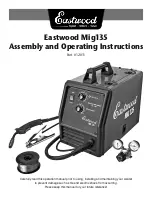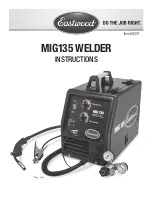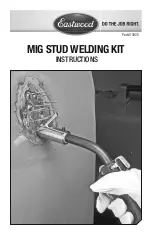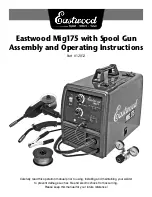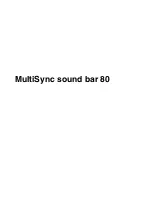
OM-252 624 Page 4
HOT METAL from air arc cutting and
gouging can cause fire or explosion.
Do not cut or gouge near flammables.
Watch for fire; keep extinguisher nearby.
COMPRESSED AIR can injure or kill.
Before working on compressed air system,
turn off and lockout/tagout unit, release pres-
sure, and be sure air pressure cannot be acci-
dentally applied.
Relieve pressure before disconnecting or con-
necting air lines.
Check compressed air system components
and all connections and hoses for damage,
leaks, and wear before operating unit.
Do not direct air stream toward self or others.
Wear protective equipment such as safety glasses, hearing pro-
tection, leather gloves, heavy shirt and trousers, high shoes, and
a cap when working on compressed air system.
Use soapy water or an ultrasonic detector to search for
leaks
−−
never use bare hands. Do not use equipment if leaks are
found.
Reinstall doors, panels, covers, or guards when servicing is
finished and before starting unit.
If ANY air is injected into the skin or body seek medical help im-
mediately.
BREATHING COMPRESSED AIR can in-
jure or kill.
Do not use compressed air for breathing.
Use only for cutting, gouging, and tools.
TRAPPED AIR PRESSURE AND WHIPPING
HOSES can injure.
Release air pressure from tools and system be-
fore servicing, adding or changing attach-
ments, or opening compressor oil drain or oil fill
cap.
MOVING PARTS can injure.
Keep away from moving parts such as fans,
belts and rotors.
Keep all doors, panels, covers, and guards
closed and securely in place.
Keep hands, hair, loose clothing, and tools away from moving
parts.
Before working on compressed air system, turn off and lockout/
tagout unit, release pressure, and be sure air pressure cannot be
accidentally applied.
Have only qualified people remove guards or covers for maint-
enance and troubleshooting as necessary.
Reinstall doors, panels, covers, or guards when servicing is
finished and before starting engine.
HOT PARTS can burn.
Do not touch hot compressor or air system
parts.
Allow cooling period before working on equip-
ment.
To handle hot parts, use proper tools and/or wear heavy, insu-
lated welding gloves and clothing to prevent burns.
READ INSTRUCTIONS.
Read and follow all labels and the Owner’s
Manual carefully before installing, operating, or
servicing unit. Read the safety information at
the beginning of the manual and in each
section.
Use only genuine replacement parts from the manufacturer.
Perform maintenance and service according to the Owner’s
Manuals, industry standards, and national, state, and local
codes.
1-5. Additional Symbols For Installation, Operation, And Maintenance
FIRE OR EXPLOSION hazard.
Do not install or place unit on, over, or near
combustible surfaces.
Do not install unit near flammables.
Do not overload building wiring
−
be sure power supply system is
properly sized, rated, and protected to handle this unit.
FALLING EQUIPMENT can injure.
Use lifting eye to lift unit and properly installed
accessories only, NOT gas cylinders. Do not
exceed maximum lift eye weight rating (see
Specifications).
Use equipment of adequate capacity to lift and
support unit.
If using lift forks to move unit, be sure forks are long enough to
extend beyond opposite side of unit.
Keep equipment (cables and cords) away from moving vehicles
when working from an aerial location.
Follow the guidelines in the Applications Manual for the Revised
NIOSH Lifting Equation (Publication No. 94
−
110) when manu-
ally lifting heavy parts or equipment.
OVERHEATING can damage motors.
Turn off or unplug equipment before starting or
stopping engine.
Do not let low voltage and frequency caused by
low engine speed damage electric motors.
Do not connect 50 or 60 Hertz motors to the 100 Hertz receptacle
where applicable.
FLYING SPARKS can injure.
Wear a face shield to protect eyes and face.
Shape tungsten electrode only on grinder with
proper guards in a safe location wearing proper
face, hand, and body protection.
Sparks can cause fires — keep flammables away.
MOVING PARTS can injure.
Keep away from moving parts.
Keep away from pinch points such as drive
rolls.


























